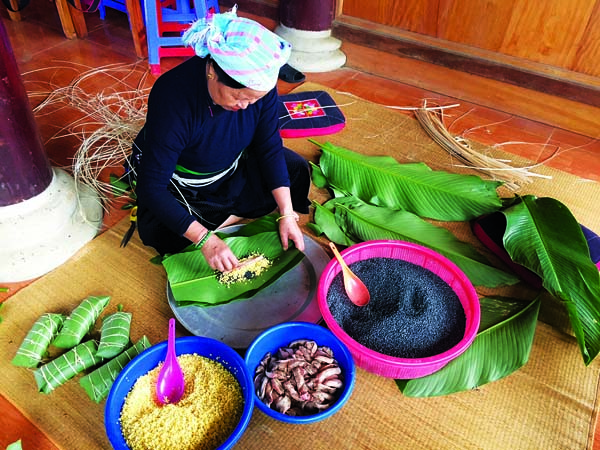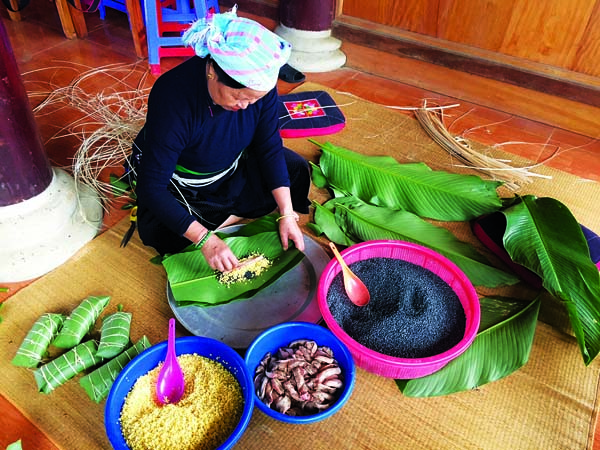(No.1, Vol.9,Feb-Mar 2019 Vietnam Heritage Magazine)



When the pale peach flowers blossom on the slope beneath Bay waterfall, as the cocks start cooing to announce a new day while the stilted houses are still only blurred dark silhouettes, the people of Liem Phu – Van Ban, Lao Cai Province get up to prepare the New Year’s Eve feast. They are bustling about making “heaven and earth” sticky rice cakes, decorating the house joyously in hope that the coming year will bring good weather, good crops peace and happiness.
At Ms. Luong Thi Hoa’s, it is much more hectic and boisterous than usual, because a group of tourists who have come to enjoy Tay ethnic New Year food and culture is having a good time. The family has been bustling about since the previous afternoon, catching fish in the creek, getting the vegetables, bamboo and canna leaves in the forest and preparing the food etc. The local breed of black pig that the family raised the whole year is slaughtered. Ms. Hoa gives calm and clear commands without rush. Receiving guests has recently become her family business. She was taught by her mother since childhood to make the delicious food items of the Tay people. Growing up by the Nhu creek, becoming a young wife and then a mother, Ms. Hoa loves cooking and everything related to it. She chose to open a restaurant at home to receive visitors who come to enjoy the beautiful nature and Tay culture at the land of Liem Phu. It is that love that brought her great joy making special meals that won her the second prize in the food fair contest of the Northwest region two years ago.
Nimbly cleaning creek fish, seasoning them and fixing them in a bamboo clip to grill and make the famous “pa pinh top” dish, Ms. Hoa said, “This is an ace at Liem Phu. Nhu Creek has so much fish that we don’t catch them. We scoop them. Tay people of Liem Phu make many seafood dishes such as mooc ca, pa pinh top, fish in a bamboo, sour fish soup with bamboo shoots etc. Not having tasted the mooc ca means not knowing Liem Phu. So, beside eco-touring the forest, learning stilted house culture and joining the Nom song and dance, tourists can also go to the Nhu Creek to scoop some fish and come back and prepare some traditional Tay dishes by themselves.”
On the courtyard near the terrace, Ms. Nguyen Thi Toong, Ms. Hoa’s mother carefully wipes clean canna leaves, one by one, to make black sticky rice cake, a Tay ethnic specialty. Almost 70 years old, Ms. Toong is still sound and fit enough to join her descendants in preparing the New Year’s Eve feast and making New Year black sticky rice cakes. She is especially cheerful because so many guests come to her house on this day. It means that many people have heard about and want to explore Tay food and culture. Having finished with cleaning the leaves, Ms. Toong begins wrapping the black sticky rice cakes, also called humpback cakes. She relates cheerfully, the terrace field sticky rice, home grown pork, canna leaves and nuc nac trees taken from the forest are all natural, clean and safe to eat. The cakes are black because the sticky rice is steeped in nuc nac ash before to acquire a very special flavor. Further baked in smoldering rice husk coal, the cake is unforgettable once eaten.
Every year, when the flow of tourists stops on the New Year’s Eve, the family slaughters a pig for consecration at the ancestral altar following the custom. Inheriting from her mother the love for the household fire, Ms. Hoa has never been absent from the kitchen, making New Year special dishes. She cuts the meat into different lots for different purposes: smoked sausage meat, meat to smoke and meat to grill. A Tay New Year won’t do without the traditional rice soup with bones, and she will make it too.
Now as the grilled fish is done, without pausing her narration, Ms. Hoa immediately takes on stir frying papaya leaves with vine aubergines and vinegarish fermented rice, a Tay version of vinaigrette. A Tay New Year special food tray, beside the black sticky rice cake, includes colored steamed sticky rice wrapped in canna leaves, dried meats, sausages, smoked pork stir fried with colza, salads with various forest vegetables etc. These food items stand ready in every household to treat visitors from the clan and around the village.
Ms. Hoa’s charisma, which can be felt even in the food she makes, seems to be also her karma that binds her with the native land. For her great ability to make wonderful Tay traditional food, especially after she won culinary prizes, many hotel and restaurant representatives have come to invite her to work for them for a salary anyone else would dream to have. But Ms. Hoa refused because she chose to stay home, preserving her traditional culture, creating jobs for her villagers and consuming the clean produces of her native land.
The simple affections to her native land of the loving woman has helped her country people earn extra money from food serviced at her house. Every day she gets at least one or two orders. Sometimes she has to serve up to 20 parties in one day. Guests come mostly from faraway places, having heard of her cooking by word of mouth. Then they fall in love with the food she makes and come back over and over again. Thus, Ms. Hoa was motivated to do a lot of research. On one hand, she asks her mother and other village elders about the way food used to be made in the deep past. On the other hand, she spent sleepless nights to invent new recipes that preserve the original tastes and flavors of Tay food.
On the floor above the ground, as the hosts finish their New Year’s Eve prayers, we join their family’s first toast of the spring, wishing one another the best things in the coming year. Somewhere nearby, a beautiful voice sings the song “My beloved Van Ban” that the village women are rehearsing for the Down to the Fields festival.

